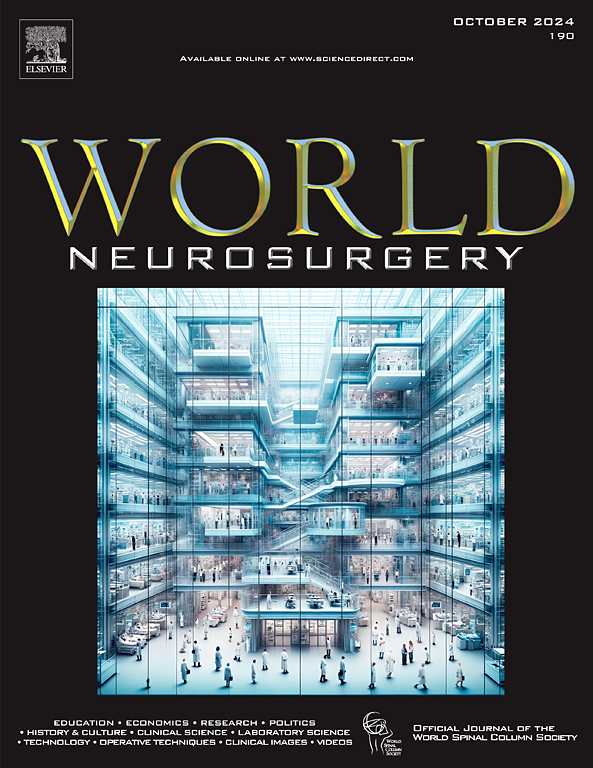颈椎狭窄患者创伤后脊髓损伤的风险:系统回顾和荟萃分析。
IF 1.9
4区 医学
Q3 CLINICAL NEUROLOGY
引用次数: 0
摘要
颈椎狭窄症(CS)是颈椎中央椎管的病理性狭窄。它常常是偶然发现的。目前尚不清楚先前存在的CS是否会导致更糟糕的结果和更高的创伤后脊髓损伤(SCI)发生率。方法:我们对以“颈椎狭窄”和(“创伤”或“损伤”)为关键词收集的研究进行了系统回顾和荟萃分析。从Pubmed、Embase和Cochrane中收集了381篇文章,最终分析了来自7项研究的2675名患者。新贝叶斯统计用于估计治疗所需的数量(NNT)。结果:在一项内部对照研究的荟萃分析中,已有CS的患者发生创伤后脊髓损伤的风险并不更高(OR 2.73, 95% CI 0.78-9.50)。然而,与没有CS的患者(0.18,95%-CI 0.14-0.22)相比,CS患者的SCI发生率更高(0.41,95%-CI 0.26-0.56)。脊髓损伤患者中CS患者的比例也过高(0.46,95% ci 0.27;0.65)。使用新贝叶斯统计,我们估计70例CS患者必须接受治疗才能预防1例SCI。在参加高风险体育活动的患者中,NNT可能更低。结论:虽然在有内部控制的研究中,已有CS的患者发生SCI的几率并不高,但我们发现CS患者发生SCI的几率确实更高,并且在SCI患者中比例过高。在选择生活方式积极的CS患者中,可能需要密切随访并考虑各种治疗方案。本文章由计算机程序翻译,如有差异,请以英文原文为准。
Risk of Post-Traumatic Spinal Cord Injury in Patients with Stenosis of the Cervical Spine: A Systematic Review and Meta-Analysis
Background
Cervical stenosis (CS) is the pathologic narrowing of the central canal of the cervical spine. It is often incidentally discovered. It is unclear whether pre-existing CS can lead to worse outcomes and higher incidences of post-traumatic spinal cord injury (SCI).
Methods
We conducted a systematic review and meta-analysis of studies collected using the keywords "cervical stenosis" AND (“trauma” OR “injury”). About 381 articles were collected from PubMed, Embase, and Cochrane, and 2675 patients from 7 studies were included in the final analyses. Neo-Bayesian statistics were used to estimate a number needed to treat.
Results
In a meta-analysis of studies with internal controls, patients with pre-existing CS are not at a higher risk of post-traumatic SCI (odds ratio 2.73, 95% confidence interval [CI] 0.78–9.50). However, CS patients have a greater incidence of SCI (0.41, 95% CI 0.26–0.56) compared to patients without CS (0.18, 95% CI 0.14–0.22). Patients with CS were also over-represented in the population of SCI patients (0.46, 95% CI 0.27; 0.65). Using neo-Bayesian statistics, we estimate that 70 patients with CS must be treated to prevent one SCI. In patients who participate in higher-risk physical activities, the number needed to treat may be lower.
Conclusions
Though patients with pre-existing CS do not have higher odds of SCI in studies with internal controls, we find that patients with CS do have higher incidences of SCI and are over-represented in the population of SCI patients. In select CS patients with active lifestyles, close follow-up and consideration of various treatment options may be indicated.
求助全文
通过发布文献求助,成功后即可免费获取论文全文。
去求助
来源期刊

World neurosurgery
CLINICAL NEUROLOGY-SURGERY
CiteScore
3.90
自引率
15.00%
发文量
1765
审稿时长
47 days
期刊介绍:
World Neurosurgery has an open access mirror journal World Neurosurgery: X, sharing the same aims and scope, editorial team, submission system and rigorous peer review.
The journal''s mission is to:
-To provide a first-class international forum and a 2-way conduit for dialogue that is relevant to neurosurgeons and providers who care for neurosurgery patients. The categories of the exchanged information include clinical and basic science, as well as global information that provide social, political, educational, economic, cultural or societal insights and knowledge that are of significance and relevance to worldwide neurosurgery patient care.
-To act as a primary intellectual catalyst for the stimulation of creativity, the creation of new knowledge, and the enhancement of quality neurosurgical care worldwide.
-To provide a forum for communication that enriches the lives of all neurosurgeons and their colleagues; and, in so doing, enriches the lives of their patients.
Topics to be addressed in World Neurosurgery include: EDUCATION, ECONOMICS, RESEARCH, POLITICS, HISTORY, CULTURE, CLINICAL SCIENCE, LABORATORY SCIENCE, TECHNOLOGY, OPERATIVE TECHNIQUES, CLINICAL IMAGES, VIDEOS
 求助内容:
求助内容: 应助结果提醒方式:
应助结果提醒方式:


